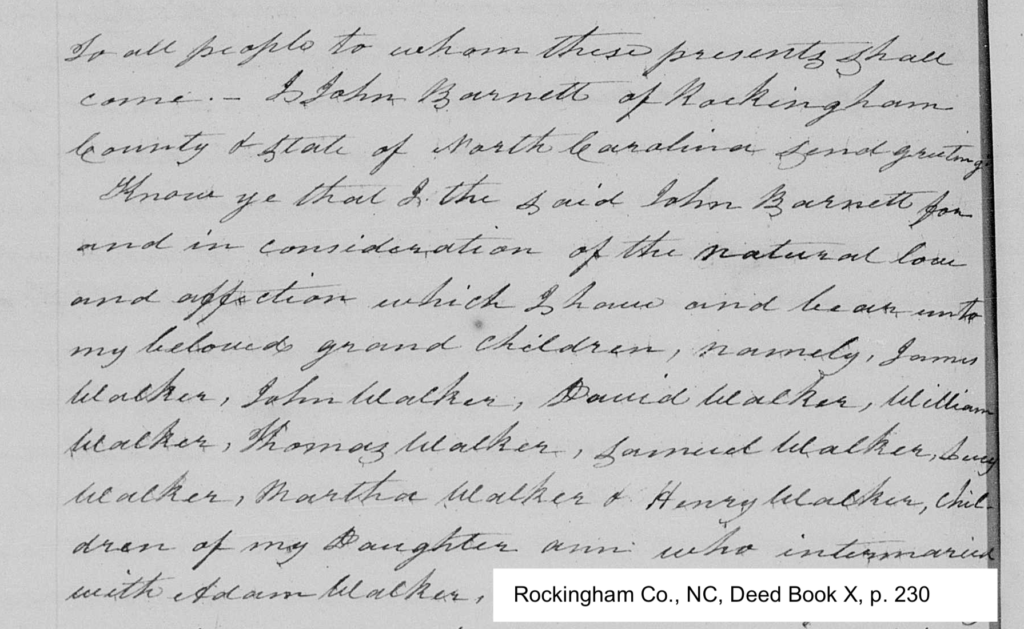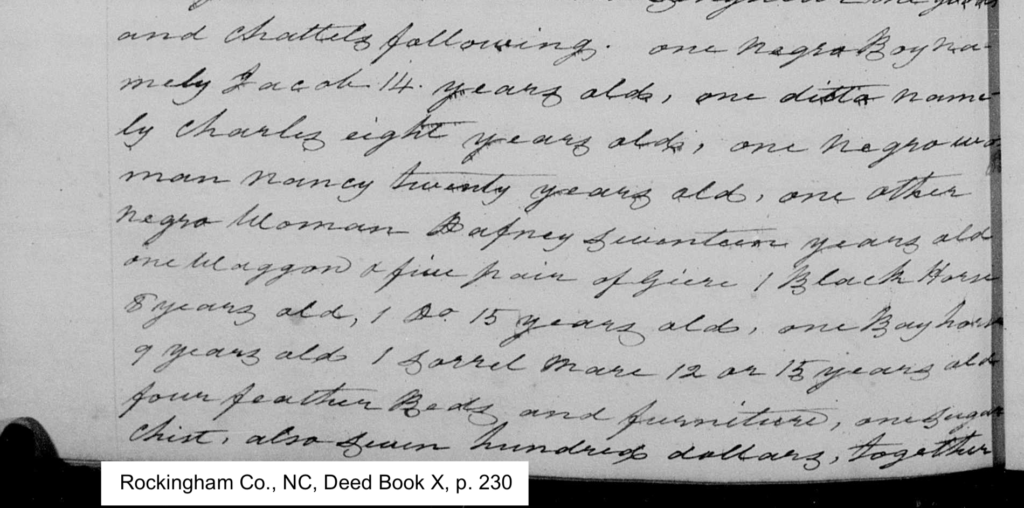A couple of months ago I was researching my 5x great-grandfather and came across a Deed of Gift in the courthouse records in Rockingham County, North Carolina.[1] My ancestor, John Barnett, gave his nine grandchildren (including my 3x-great grandfather) a present on 6 March 1823. The Deed of Gift began innocently enough:
“To all people to whom these presents shall
come. _ I John Barnett of Rockingham
County & State of North Carolina send greetings
Know ye that I the said John Barnett for
and in consideration of the natural love
and affection which I have and bear unto
my beloved grand children, namely, James
Walker, John Walker, David Walker, William
Walker, Thomas Walker, Samuel Walker, Lucy
Walker, Martha Walker & Henry Walker, chil-
dren of my Daughter Ann who intermarried
with Adam Walker…”

At this point, my genealogist brain said “excellent, I now have an original document with primary information directly linking Ann Barnett to her father, her husband, and all of her children in Rockingham County, North Carolina in 1823.” These generational links form the foundation of a well-documented family tree.
As I read on, the sinking feeling began as the gift was described:
“…one Negro Boy na-
mely Jacob 14 years old, one ditto name-
ly Charles eight years old, one Negro wo-
man Nancy twenty years old, one other
Negro Woman Dafney seventeen years old
one waggon & five pair of Giere [geese?] 1 Black Horse
8 years old, 1 Do [ditto] 15 years old, one Bay horse
9 years old 1 Sorrel Mare 12 or 15 years old
four feather Beds and furniture, one Sugar
chest, also seven hundred dollars,
with all the Increase of said property…”

My ancestor gave Jacob, Charles, Nancy, and Dafney to his grandchildren as chattel. He also gave any of their children away as chattel. My ancestor destroyed the desires, dreams, and relationships of these four people by owning them and selling them. This gift took place prior to the Adam Walker family’s relocation to Perry County, Tennessee, and likely tore families apart. My ancestor’s actions are part of the multigenerational transmission of harm to African Americans. This harm, or historical trauma, carries a legacy of “beliefs, ideas, myths, prejudices, biases and behaviors that are disseminated and then inherited by and/or about differing groups.”[2] The aftermath of this legacy is the systematic and structural racism that persists in North America.
I have known for over thirty years that some of my ancestors were enslavers. I found my ancestors in the slave schedules of the 1850 and 1860 censuses with the lists of unnamed people they held in bondage. My mother discovered a scrap of paper in the Benton County, Tennessee, Historical Society records describing the sale of Mary Jane from one ancestor to another.[3] Although never far from my mind, this information had become far from my heart. John Barnett’s Deed of Gift brought it back into my heart.
My response to this knowledge has changed. Instead of logging it away in my genealogy program and citing the sources faithfully, I have begun the process of “Transforming Historical Harms” as recommended by Hooker and Czajkowski:
Facing History
Making Connections
Healing Wounds
Taking Action
I am finding my own way forward to face history, make connections, heal wounds, and take action. It is a small thing compared to the harm so many African Americans experienced and continue to experience. I share these early steps in my journey with the hope of encouraging you on your own.
In the past two years I have focused on learning about racism and the American history that I was not taught in school. This education will continue for the rest of my life. As a citizen of two countries (the United States and Canada), facing history is both a societal imperative and specific to my family. Reading and learning about systematic and structural racism led me to Coming to the Table (CTTT), a non-profit with a core of genealogical research dedicated to facing history and healing racial wounds created by slavery and its impact. I participate in the Linked Descendants group. With support from Coming to the Table, I became a Strategies for Trauma Awareness and Resilience practitioner, and I am learning and practicing ways to address historical trauma. I’ve joined the U.S. Black Heritage Exchange program WikiTree project and wrote about that experience in a guest blog for Research Like a Pro. I am entering the records of enslavers and those that were enslaved into WikiTree in hopes of helping others discover their family history. As a citizen and a health care professional, I will continue to take action, speak out, donate time and resources, and be part of the long process of righting the historical harms written into history, like John Barnett’s Deed of Gift.
The story of Jacob, Charles, Nancy, and Dafney reminds all of us of the debt owed to the people who built the wealth of the North American continent. How can we individually and collectively face history, make connections, heal wounds, and take action? What’s next for you?
[1] Rockingham County, North Carolina, “Deed Book X,” pages 230-232, John Barnett to his grandchildren James Walker, John Walker, David Walker, William Walker, Thomas Walker, Samuel Walker, Lucy Walker, Martha Walker and Henry Walker, Deed of Gift, 6 March 1823; digital images, FamilySearch (https://www.familysearch.org/ark:/61903/3:1:3QS7-L98Q-3QYR : accessed 5 November 2021), FHL Film #007517701; citing North Carolina Department of Archives and History, Raleigh.
[2] David Anderson Hooker and Amy Potter Czajkowski, “Transforming Historical Harms,” Eastern Mennonite University (https://emu.edu/cjp/docs/transforming-historical-harms.pdf : accessed 13 February 2022), page 15.
[3] Benton County, Tennessee, “Deed Book F, Jan 1857-Apr 1860,” page 291-292, Thomas Walker to H. Kee, Negro girl named Mary Jane, 6 August 1857; digital images, FamilySearch (https://www.familysearch.org/ark:/61903/3:1:3Q9M-CS5H-9SYD-W and https://www.familysearch.org/ark:/61903/3:1:3Q9M-CS5H-9SYN-C : accessed 21 November 2021); citing Tennessee State Library and Archives, Nashville.
